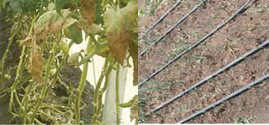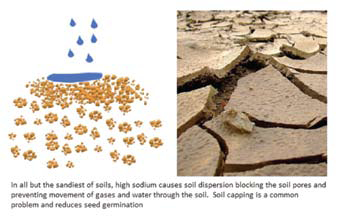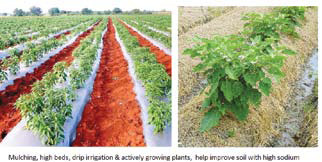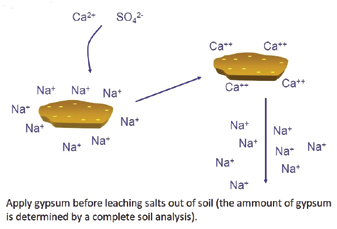In Africa, and especially in Kenya, sodium is one of the major causes of yield losses, quality reduction and crop failure in irrigated agriculture. Writes Ruth Vaughan.
Soils with a high percentage of sodium in the soil are called sodic soils. Sodic soils negatively impact plant growth for several reasons:
- Specific ion toxicity to sodium sensitive plants.
- Nutrient deficiencies or imbalances in the plants.
- High soil pH – resulting in lock up of phosphates, iron and other micronutrients.
- Dispersion of clay and silt particles in the soil – collapsing the soil structure and blocking soil pores.

Where does soil sodium come from? In low rainfall areas with high evaporation, like many parts of Kenya, sodium and other salts build up in the soil surface over time. This effect is rapidly enhanced due to over grazing, which removes the plant cover and compacts the soil, reducing water infiltration and causing a salt build up. In coastal areas sodium comes from sea spray and sea salt in the rain. Irrigating the soil with water containing high sodium is a major cause of high soil sodium in Kenya. It is important to identify the root cause of the sodium build up so you can deal with it. If you are irrigating, the FIRST thing to test is the water quality, with an irrigation water analysis.
High sodium levels compete with calcium, potassium and magnesium for uptake by plant roots. Some plants are very sensitive to sodium including potatoes, beans, woody plants, vines and stone fruits. Sodium toxicity can be seen as necrosis of leaf tips and plant yellowing like these tomato plants in Thika, and onions in Naivasha. Long before you see the classic toxicity symptoms in the plant leaves – you will notice the plants struggling with high pest and disease pressure. Spidermite infestations are very often associated with high sodium. Death of plants from Fusarium is very common in sodic soils. To reduce sodium toxicity plant sodium tolerant plant species or sodium tolerant varieties. Don’t struggle with sodium sensitive plants in high sodium soils – you will never win.

Soil nutrient imbalances, high pH soil and soil structure can all be improved by getting a complete soil analysis and looking at the cation percentages. The soil correction recommendations will help reduce the sodium in the soil, improve the soil structure and address nutrient imbalances. Ideally this should be done before you plant, but you can still do this in long term crops like roses, while the plants are still growing.
Sodium levels are reported as exchangeable sodium percentage (ESP. At an ESP of 5% the soil structure starts to break down, and water infiltration reduces. As water infiltration reduces, the sodium quickly builds up, creating a rapid upward spiral in sodium levels and a fast collapse of soil properties and plant health. At an ESP of 15%, pretty much everything goes wrong and the soil is very difficult and very expensive to rehabilitate. The earlier you deal with sodium the better.
The effect of sodium on soil structure depends on the amount of clay or silt in the soil. The cation exchange capacity (CEC) gives an indication of soil type. Heavy soils with a high clay content and fine silty soils like those in the Rift Valley, are highly affected by sodium. The sodium attaches to the soil particles making them repel each other. This disperses the soil and breaks down the soil crumb structure. These small particles move in the soil water and block the soil pores that are so important for root growth, gaseous exchange (oxygen in and carbon dioxide out) and water movement.

Sodium builds up when water cannot infiltrate easily through the soil. Dig soil pits in your fields to look for a hard pans or concrete layers that prevent water movement and salt leaching. Hard pans are more common in clay based soils, concrete layers in silty soils. These compacted layers need to be physically broken up by deep ripping or deep digging, to shatter, without turning the soil over and burying the valuable topsoil. You cannot remove sodium without leaching which needs free water movement through the soil profile. Adding organic matter and humic/fulvic acids will improve the soil crumb structure, increasing the water infiltration rate and leaching potential of the sodium. Mulching the surface will reduce evaporation and soil capping. Keeping active plant roots and crop residues in the field will further improve soil structure and water infiltration. Building high beds will improve water infiltration and movement of salts away from the root zone. Irrigating with slow drip irrigation will reduce evaporation,improve water infiltration. Large rain droplets and overhead sprinklers will increase soil capping through physical action. Your soil analysis results will have a soil fertility correction recommendation, which tells you the right amount of gypsum to apply. The gypsum can be mixed into the soil at planting or surface applied in the case of permanent crops like roses, coffee and fruit trees. If you cannot afford to apply the gypsum in one go, you can plan the application over a year or two. However the sooner you can apply, the sooner your yields will improve.
 How does gypsum work? The calcium in the gypsum has a higher attraction to the negatively charged soil particles than the sodium and ‘kicks’ the sodium off into the soil solution where it can be leached out. The calcium improves the crumb structure of the soil, counteracting the soil dispersion and improving water infiltration, allowing the water with the sodium to leach out.
How does gypsum work? The calcium in the gypsum has a higher attraction to the negatively charged soil particles than the sodium and ‘kicks’ the sodium off into the soil solution where it can be leached out. The calcium improves the crumb structure of the soil, counteracting the soil dispersion and improving water infiltration, allowing the water with the sodium to leach out.
Dispersed sodic soils repel water when dryand block up when wet. The EC of the applied water affects its ability to ‘wet’ sodic soil and penetrate the soil structure, fertigation with fertilized water with a higher EC is better than applying fresh water. Keep a fine layer of gypsum on the soil surface at all times, this improves wettability and brings in extra calcium to counteract the sodium. You can also add specialized dispersing agents like humic acids and liquid soaps.
If you are concerned about sodium in your soil, I hope by now that you have had a look at previous soil analysis results or have organized for a proper soil analysis to be done by contacting us on support@cropnuts. com. To look for gypsum or salinity correction products please our on line product directory http://shambaza.com
